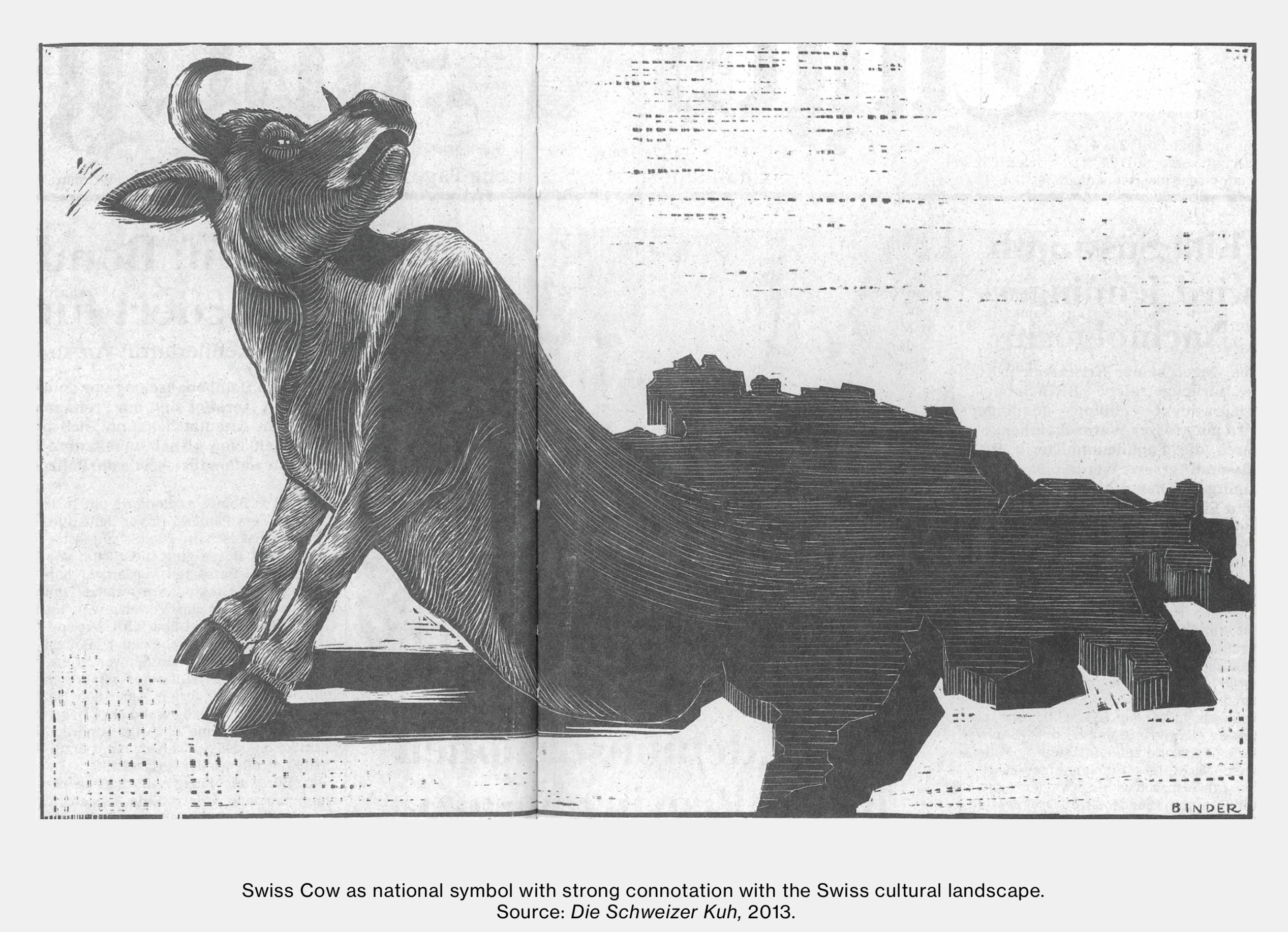land under the cow's hoof
Cows dominate the Swiss landscape, even on the outskirts of Zurich. And even when they are not in sight, a lot of land is used by them.
90% of Swiss agricultural land is used to feed animals; 70% as pasture and 20% for growing fodder. In addition, there are 200'000 ha abroad, which corresponds to about 15% of Swiss agricultural land.
There are 1'500'000 cattle in Switzerland next to 1'400'000 pigs, 340'000 sheep, 80'000 horses, 80'000 goats and 11'500'000 chickens. (1) In order to better classify the animals, they are referred to as «Grossvieheinheiten» which corresponds to about 500 kilograms of animal, roughly the weight of a full-grown cow. This means that 3 cows half a year old together make one «Grossvieheinheiten», just like 2 adult pigs, 4 sheep, 30 rabbits or 100 chickens. (2) At the moment we have 1'300'000 imaginary full-grown cows in Switzerland.
When we talk about animal land use, we have to keep in mind that not all animals are able to eat grass like cows do. Pigs, for example, are much more dependent on corn and thus on the area that is not used as pasture. Although there are almost as many pigs as cows in Switzerland, in terms of «Grossvieh- einheiten» the ratio is only 175'000 to 945'000. All other animals together have the equivalent of 200'000. This ratio is also due to the fact that many animals do not grow up completely, but are slaughtered after only a few months. A pig, for example, would have a life expectancy of 20 years, but is slaughtered after only 5 months. (3) Cows for milk production on the other hand have to grow fully up and are only slaughtered after a few years. Therefore cows have the greatest impact of all the animals in Switzerland on the Swiss landscape. This is one explanation for the large areas of land used as pasture.
Beside this, there are geographical reasons for the large proportion of pastureland on agricultural land. Most land, even on «Mittelland», is not flat, which is why the BLW has divided Switzerland into seven different zones: Talzone, Hügelzone, Bergzone 1-4 and Sömmerungsgebiet. (4)
Everything except the valley zone is not suitable for growing wheat and vegetables. For one thing, the slopes are difficult to cultivate with large machines and for another, it is not possible to irrigate the slopes. Moreover, there are other climatic conditions in the mountains that make the cultivation of some varieties impossible.
The cow and the Swiss geography go very well together. The cow is agile and can graze the hilly landscape well. With the ability to eat grass, the cow has been important in building fertile soil over the centuries. Cows can be seen as living food stores that can be slaughtered in times of scarce food, in good times they give milk. This milk can be stored in the form of cheese. One can only guess the importance of the cow in the small-scale farming structure of earlier times.
Today the situation has changed a lot. Until 2009, the milk market was regulated with quotas. A quota was linked to a purchase guarantee at a fixed price, which used to be 0.75 Swiss francs per litre. Today the market price is 0.58 francs. In order to be able to produce profitably, a certain size of farm is needed. Fewer farms have more cows and the individual cow is much more efficient in growing and producing milk. Additional food can be bought abroad, which is necessary for these high performances. Most additional animal feed comes from France, Germany and Brazil. Feed imports lead to a loss of fertility in the exporting country and to a surplus in our country, because the nutrient cycles are not closed. At the same time, there are strong local accumulations because of these larger farms. Once an investment has been made in an automatic milking system or a large barn, it is also difficult to get out of the business again.
If we want to arrive at an appropriate way of keeping animals in Switzerland, we need to halve the number of animals, and thereby also halve our meat and milk consumption.
(1) - STAT-TAB – interaktive Tabellen,
BFS
(2) - Kanton Zürich,
Amt für Landschaft und Natur
(3) - Swissveg,
Lebenserwartung
(4) - Bundesamt für Landwirtschaft,
Landwirtschaftliche Zonen
(5) - BFS, Landwirtschaftliche Strukturerhebung
Landwirtschaftliche Zonen
(6) - Die Schweizer Kuh, Kult und Vermarktung eines nationalen Symbols, Marc Valance, 2013
images
1 - Hönggerberg, BSV
2 - BLW, drawn by BSV
3 - BLW, Copernicus Land Service, drawn by BSV
4 - Hannes Binder, Tages-Anzeiger, 19.11.1988.

1 - Cows on the city outskirts
ETH Hönggerberg

2 - Classification according to mountainousness
Landwirtschaftliche Zonengrenzen

3 - Zones minus all non-agricultural land
Landwirtschaftliche Zonengrenzen & Bodenabdeckung

4 - the cow needs 80% of swiss agricultural land
Die Schweiz als Kuh



